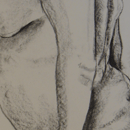| |
|
Through experience, many visual artists develop a tool kit of optical tricks for convincing the brain to interpret an image or painting as an object, landscape, portrait etc. This accomplishment is remarkable because in reality of the visual input is just an assemblage of marks on a two dimensional surface. The artist uses these tricks to construct illusions of depth, color, light and form; and to guide visual attention or evoke emotional responses. By examining these tricks we can learn something important about how our visual system handles visual information because the success of these tricks lies in their ability to capitalize on the structure inherent in the neural mechanisms of visual processing. In addition, insight into studio practice might lead us to ask probing questions and design creative experiments we otherwise might not think to ask or conduct.
At the same time, the mistakes common to inexperienced artists prove just as useful. We are all equipped with the same neural hardware, so when faced with the task of putting our three dimensional perceptual experience down on a two dimensional surface we tend to trip over the same processing hitches. Identifying these common difficulties can provide insight into how our brains are handling visual information. By getting directly involved in studio practice—making art!—we can begin to develop an intuition for the tricks of the artist, which will help make tangible some of the things we know about how the visual system works, and many of the mysteries. Accordingly, studio sessions and subsequent critiques play an integral role in the course.
Sample Student Artwork in Vision&Art Course
|
 |
 |
 |
 |
 |
| Credits |
|
|
| |
Created by : Kate Ciurej ‘08 and Donna Yee ’11
Created: July 9, 2008
Maintained By: Bevil Conway
Last Modified:July 21, 2013
Expires: July 21, 2013 |